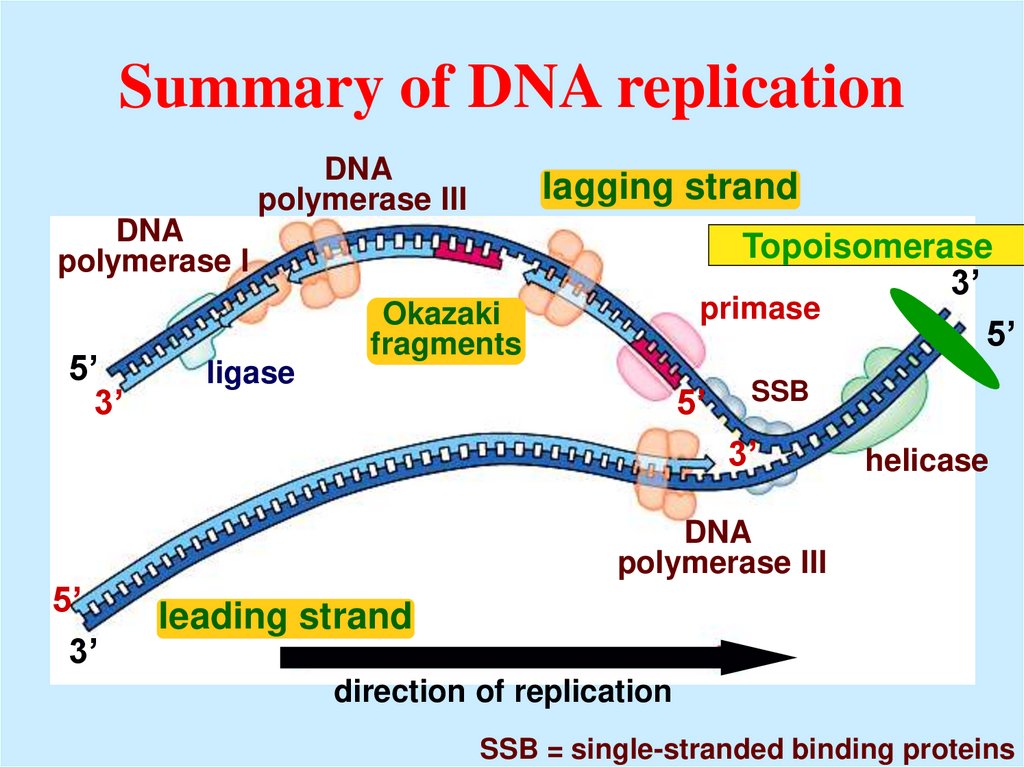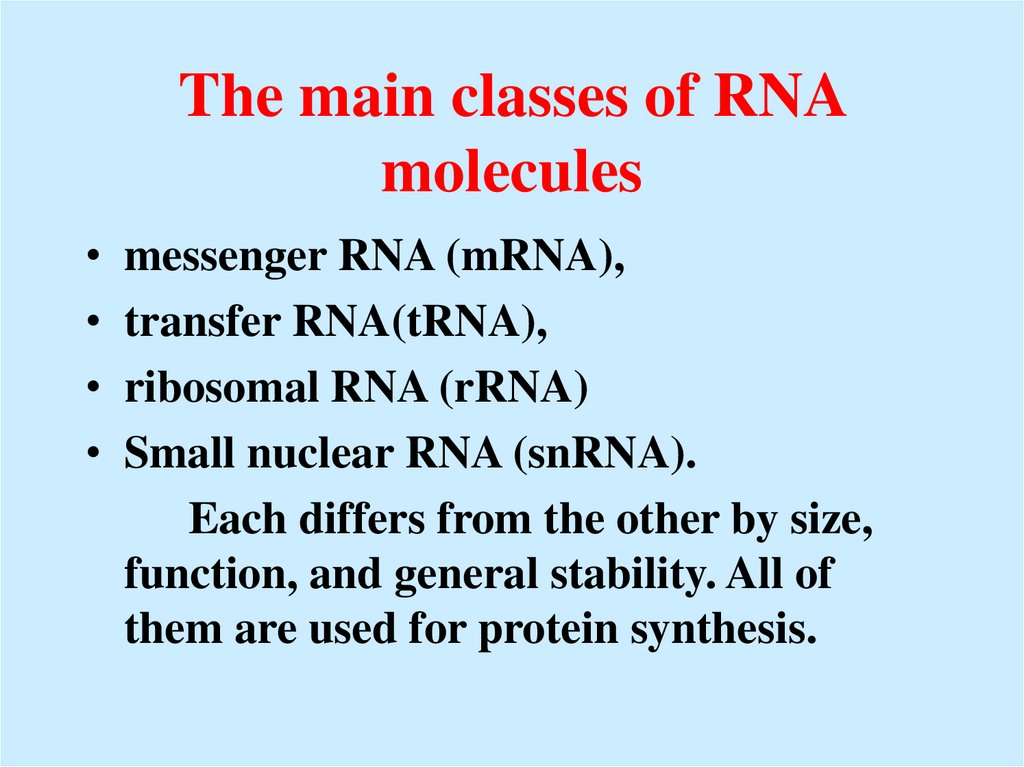Similar presentations:
DNA RNA Protein
1.
DNA2. DNA RNA Protein
ReplicationDNA
Transcription
RNA
Translation
Protein
3. DNA replication
Occurs during cell division.Replication: is synthesis of daughter nucleic acid
molecules identical to the parental nucleic acid.
4. Replication of the DNA proceeds in stages:
• Initiation• Elongation
• Termination
• DNA replication requires many enzymes and
protein factors.
• This complex has been termed
the DNA replicase system or replisome.
5.
The Watson-Crick Model•Semi-conservative
replication of DNA
•Replication is very accurate.
6. DNA Replication 1) Initiation
Origins of replicationThe initiation point where Replication Bubbles:
the splitting starts is called a. Hundreds of replicating bubbles
"origin of replication". (Eukaryotes).
b.Single replication fork (bacteria).
7. Initiation of replication: 1st step (Strand Separation)
1. Helicase - unwind short segment of the parental DNAbidirectionally and create two replication forks;
Helicase hydrolyzes ATP in order to break the hydrogen
bonds between DNA strands
2. Single stranded DNA binding proteins (SSB) stabilize
the separated strands and prevent renaturation of DNA
helicase
single-stranded binding proteins
replication fork
8. Initiation of DNA Replication
Initiation
of
DNA
Replication
Strand Separation:
3. Topoisomerase: enzyme which relieves
stress
on the DNA molecule by allowing free rotation
around a single strand.
Topoisomerase I Topoisomerase II
9. DNA Replication
• Strand Separation:3. Topoisomerase: enzyme which relieves
stress
on the DNA molecule by allowing free rotation
around a single strand.
Enzyme
DNA
Enzyme
10. 2. Elongation - Both Template strands are copied at a Replication Fork
• DNA replication is cataly by DNA polymerase whichneeds an RNA primer. DNA Polymerase cannot
Initiate new strands, because unable to covalently link
the 2 individual nucleotides together.
• RNA primase synthesizes primer on DNA strand
• DNA polymerase adds nucleotides to the 3’ end of
the growing strand
11. DNA Replication 2. Elongation
• Priming:1. RNA primers: before new DNA strands can form,
there must be small pre-existing
primers
(RNA) present to start the addition of
new
nucleotides (DNA Polymerase).
2. Primase: enzyme that polymerizes
(synthesizes) the RNA Primer.
12. DNA Replication 2. Elongation
• DNA polymerase IIIkeeps pace with the
replication fork.
DNA
Polymerase III
• On the leading
(forward) strand, the
DNA is synthesized
continuously in the
direction taken by the
replication fork
13. Energy of Replication
Where does energy for bonding usually come from?energy
energy
ATP
GTP
CTP
TTP
modified nucleotide
CMP
TMP
GMP
AMP
ADP
14. Replication
• Adding bases– can only add
nucleotides to 3 end
of a growing DNA
strand
• need a “starter”
nucleotide to
bond to
– strand only grows
5 3
5
3
energy
DNA
Polymerase III
energy
DNA
Polymerase III
energy
DNA
Polymerase III
DNA
Polymerase III
energy
3
5
15. The Mechanism of DNA Replication
• DNA synthesis on the leading strand is continuous• The lagging strand grows the same general direction as the
leading strand (in the same direction as the Replication Fork).
However, DNA is made in the 5’-to-3’ direction
• Therefore, DNA synthesis on the lagging strand is
discontinuous
• DNA is added as short fragments (Okasaki fragments) that are
subsequently ligated together
16. Leading & Lagging strands
OkazakiLeading & Lagging strands
Limits of DNA polymerase III
– can only build onto 3 end of an
existing DNA strand
5
3
5
3
5
3
5
5
5
3
Lagging strand
ligase
growing
3
replication fork
Leading strand
3
Lagging strand
– Okazaki fragments
– joined by ligase
• “spot welder” enzyme
5
3
DNA polymerase III
Leading strand
– continuous synthesis
17. Replication fork / Replication bubble
35
5
3
DNA polymerase III
leading strand
5
3
3
3
5
5
5
5
3
lagging strand
3
5
3
5
lagging strand
5
5
leading strand
growing
replication fork 5
3
growing
replication fork
leading strand
3
lagging strand
5 5
5
5
3
18. Starting DNA synthesis: RNA primers
Limits of DNA polymerase III– can only build onto 3 end of an
existing DNA strand
5
3
3
5
5
3
5
3
5
growing
3
replication fork
DNA polymerase III
primase
RNA 5
RNA primer
– built by primase
– serves as starter sequence for DNA
polymerase III
3
19. Replacing RNA primers with DNA
DNA polymerase I removes sections of RNA primer andreplaces with DNA nucleotides
DNA polymerase I
5
3
3
5
5
ligase
growing
3
replication fork
RNA
5
3
•Polymerase activity of DNA polymerase I fills the gaps.
•Ligase forms bonds between sugar-phosphate backbone.
20. Replication
3’3’
5’
5’
3’
5’
3’
5’
Helicase protein binds to DNA sequences called
origins and unwinds DNA strands.
Binding proteins prevent single strands from rewinding.
Primase protein makes a short segment of RNA
complementary to the DNA, a primer.
21. Replication
Overall directionof replication
3’
3’
5’
5’
3’
5’
3’
5’
DNA polymerase enzyme adds DNA nucleotides
to the RNA primer.
22. Replication
Overall directionof replication
3’
5’
3’
5’
3’
5’
3’
5’
DNA polymerase enzyme adds DNA nucleotides
to the RNA primer.
DNA polymerase proofreads bases added and
replaces incorrect nucleotides.
23. Replication
Overall directionof replication
3’
3’
5’
5’
3’
5’
Leading strand synthesis continues in a
5’ to 3’ direction.
3’
5’
24. Replication
Overall directionof replication
3’
3’
5’
5’
Okazaki fragment
3’
5’
3’ 5’
Leading strand synthesis continues in a
5’ to 3’ direction.
Discontinuous synthesis produces 5’ to 3’ DNA
segments called Okazaki fragments.
3’
5’
25. Replication
Overall directionof replication
3’
3’
5’
5’
Okazaki fragment
3’
5’
3’ 5’
Leading strand synthesis continues in a
5’ to 3’ direction.
Discontinuous synthesis produces 5’ to 3’ DNA
segments called Okazaki fragments.
3’
5’
26. Replication
3’5’
3’
5’
3’
5’
3’ 5’
3’5’
3’
5’
Leading strand synthesis continues in a
5’ to 3’ direction.
Discontinuous synthesis produces 5’ to 3’ DNA
segments called Okazaki fragments.
27. Replication
3’5’
3’
5’
3’
5’
3’5’
3’5’
3’
5’
Leading strand synthesis continues in a
5’ to 3’ direction.
Discontinuous synthesis produces 5’ to 3’ DNA
segments called Okazaki fragments.
28. Replication
3’5’
3’
5’
3’
5’
3’5’
3’5’
3’
5’
Exonuclease activity of DNA polymerase I
removes RNA primers.
29. Replication
3’3’
5’
3’
5’
3’5’
3’
5’
Polymerase activity of DNA polymerase I fills the gaps.
Ligase forms bonds between sugar-phosphate backbone.
30.
31. Final step in the synthesis of lagging strand segments.
DNA ligase catalyzes the formation of the phosphodiester bondbetween pieces of DNA.
Lagging strand
rNMPs
dNTPs
ATP (or NAD+)
AMP + Ppi (or NMN)
DNA polymerase I
DNA ligase
32. DNA ligase adds sugar phosphate back-bone between the Okazaki ragments (fill in gaps)
33. 3. Termination
This process happens when the DNA Polymerase reaches to an end of the strands.The DNA Replication is not completed before a mechanism of repair fixes possible
errors caused during the replication. Enzymes like nucleases remove the wrong
nucleotides and the DNA Polymerase fills the gaps.
34. Enzymes in DNA replication
Helicase unwindsparental double
helix
DNA polymerase III
binds nucleotides
to form new strands
Primase adds
Binding proteins short primer
stabilize
to template strand
separate
strands
DNA polymerase I
(removes RNA
primer and inserts
the correct bases
Ligase joins
Okazaki
fragments
35. Summary of DNA replication
DNApolymerase III
lagging strand
DNA
polymerase I
5’
3’
ligase
Topoisomerase
3’
primase
5’
Okazaki
fragments
5’
SSB
3’
helicase
DNA
polymerase III
5’
3’
leading strand
direction of replication
SSB = single-stranded binding proteins
36. Editing & proofreading DNA
Editing & proofreading DNA• 1000 bases/second =
lots of typos!
• DNA polymerase I
– proofreads & corrects typos
– repairs mismatched bases
– removes abnormal bases
• repairs damage
throughout life
– reduces error rate from
1 in 10,000 to
1 in 100 million bases
37.
38.
Part I39.
The “Central Dogma” of Molecular GeneticsTranscription Translation
DNA
RNA
Protein
RNA processing
Trait
40. The chemical nature of RNA differs from that of DNA.
Ribonucleic acid (RNA) is a polymer of
purine and pyrimidine ribonucleotides linked
together by 3’,5’-phosphodiester bridges.
1. In RNA, the sugar moiety is ribose.
2. Instead of thymine, RNA contains the
ribonucleotide of uracil.
3. RNA exists as a single stand.
4. The guanine and adenine content does not
necessarily equal their cytosine and uracil
content.
41. The main classes of RNA molecules
messenger RNA (mRNA),
transfer RNA(tRNA),
ribosomal RNA (rRNA)
Small nuclear RNA (snRNA).
Each differs from the other by size,
function, and general stability. All of
them are used for protein synthesis.
42.
Sn RNAnucleus
RNA splicing:
Recently, a new class of RNA, microRNA, has been shown to
regulate gene expression.
43. Protein synthesis
Nuclearenvelope
TRANSCRIPTION
DNA
Pre-mRNA
RNA PROCESSING
mRNA
Ribosome
TRANSLATION
Polypeptide
44. Transcription is DNA-dependent synthesis of RNA.
• Transcription is catalyzed by RNA polymerase.• RNA polymerase copies a DNA template in the
3’ to 5’ direction and synthesizes a singlestranded RNA molecule in a 5’ to 3’ direction.
• There are three stages of transcription:
1. Initiation
2. Elongation
3. Termination
45. Transcription.
46.
Transcription (Initiation)RNA polymerase binds to a
region on DNA known as the 1)
promoter, which signals the
INITIATIO
start of a gene
N
Promoters are specific to genes
RNA polymerase does not need
a primer
Transcription factors assemble
at the promoter forming a
transcription initiation complex
– activator proteins help stabilize
the complex
Gene expression can be
regulated (turned on/off or
up/down) by controlling the
amount of each transcription
factor
(eukaryotes)
47.
Transcription (Elongation)RNA polymerase
unwinds the DNA and
breaks the H-bonds,
separating them from one
another
Base pairing occurs
between incoming RNA
nucleotides and the DNA
nucleotides
RNA polymerase
catalyzes bond to form
between ribose of 3’
nucleotide of mRNA and
phosphate of incoming
RNA nucleotide
AGTCAT
UCAGUA
48.
Transcription (Elongation)The gene occurs on only one of the
DNA strands; each strand possesses a
separate set of genes
49.
Transcription (Termination)• Specific sequences in the DNA signal
termination of transcription
• When one of these is encountered by the
polymerase, the RNA transcript is released
from the DNA and the double helix can zip up
again.
50. RNA processing
of 7-methylguanosine51.
Each end of a pre-mRNA molecule ismodified in a particular way
– The 5 end receives a modified nucleotide cap
– The 3 end gets a poly-A tail
Protein-coding segment
Polyadenylation signal
5
5 Cap
5 UTR
Start codon
Stop codon
3 UTR
UTR: untranslated regions
Poly-A tail
52. RNA Processing - Splicing
• The original transcriptfrom the DNA is called
pre-mRNA.
• It contains transcripts of
both introns and exons.
• The introns are removed
by a process called
splicing to produce
messenger RNA
(mRNA)
53. RNA splicing
Spliceosomes complex of proteinsand several small nuclear
ribonucleoproteins
(snRNPs)
Recognize splice sites
(specific RNA sequences)
cleave out introns and
splice together exons
(coding region)
54.
RNA splicingAnimation
55. Alternative RNA splicing
• Some genes can encode more than one kind ofpolypeptide
-different combinations of exons can be
spliced together
• Increases the potential number of different
proteins (and thus functions) in an organism
56.
Thankyou
























































 biology
biology








